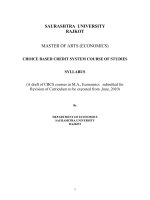HOLOGRAPHIC PROBES in university
Bạn đang xem bản rút gọn của tài liệu. Xem và tải ngay bản đầy đủ của tài liệu tại đây (5.17 MB, 37 trang )
HOLOGRAPHIC PROBES !
OF !
COLLAPSING BLACK HOLES
Veronika Hubeny!
Durham University & Institute for Advanced Study
New frontiers in dynamical gravity workshop
Cambridge, March 26, 2014
Based on work w/ H. Maxfield, M. Rangamani, & E. Tonni:!
VH&HM: 1312.6887 + VH, HM, MR, ET: 1306.4004 + VH: 1203.1044
Supported by STFC, FQXi, & The Ambrose Monell Foundation
AdS/CFT correspondence
String theory (∋ gravity) ⟺ gauge theory (CFT)
“in bulk”
asymp. AdS × K
“on boundary”
Invaluable tool to:
Use gravity on AdS to learn about strongly coupled field theory!
(as successfully implemented in e.g. AdS/QCD & AdS/CMT programs)!
Use the gauge theory to define & study quantum gravity in AdS
Pre-requisite: Understand the AdS/CFT ‘dictionary’...!
esp. how does spacetime (gravity) emerge?
One Approach: Consider natural (geometrical) bulk constructs
which have known field theory duals! eg. Extremal surfaces
(We can then use these CFT `observables’ to
reconstruct part of bulk geometry.)
Motivation
Gravity side:
Black holes provide a window into quantum gravity!
e.g. what resolves the curvature singularity?!
Study in AdS/CFT by considering a black hole in the bulk!
Can we probe it by extremal surfaces?!
Not for static BH [VH ’12] !
Certainly for dynamically evolving BH (since horizon is teleological) [VH ’02, Abajo-Arrastia,et.al. ’06]
use rapidly-collapsing black hole in AdS Vaidya-AdS!
& ask how close to the singularity can extremal surfaces penetrate?
CFT side:
Important question in physics: thermalization (e.g. after global quantum quench)
[VH,Rangamani,Takayanagi; Abajo-Arrastia,Aparacio,Lopez ’06;!
use AdS/CFT…!
(recall: BH = thermal state)
Practical aspect for numerical GR:
Balasubramanian et.al.; Albash et.al.; Liu&Suh; …]
what part of bulk geometry is relevant?
(can’t stop at apparent horizon!)
Building up Vaidya-AdS
start with vacuum state in CFT
= pure AdS in bulk
at t=0, create a short-duration
disturbance in the CFT (global quench)
this will excite a pulse of matter (shell)
in AdS which implodes under evolution
gravitational backreaction: collapse to
a black hole CFT ‘thermalizes’
large CFT energy
large BH
causality geodesics (& extremal
surfaces) can penetrate event horizon
[VH ’02]
black hole!
horizon
singularity
Choice of spacetime & probes
Bulk spacetime: Vaidya-AdS
d+1 dimensions qualitatively different for d=2 & higher
null thin shell
choose d=2, 4!
maximal deviation from static case!
extreme dynamics in CFT (maximally rapid quench)!
spherical geometry
richer structure: can go around BH!
explore finite-volume effects in CFT
Bulk probes:
monotonic behaviour in dimensionality
choose lowest & highest dim.!
spacelike geodesics anchored on the boundary w/ endpoints @ equal time!
2-point fn of high-dimensions operators in CFT (modulo caveats…)!
co-dimension 2 spacelike extremal surfaces (anchored on round regions)!
entanglement entropy
Naive expectations
These are ALL FALSE!
At late times, BH has thermalized sufficiently s.t. extremal
surfaces anchored at late time cannot penetrate the horizon.!
There can be at most 2 extremal surfaces anchored on a given
region (one passing on either side of the black hole).!
Geodesics with both endpoints anchored at equal time on the
boundary are flip-symmetric.!
Length of geodesic with fixed endpoint separation should
monotonically increase in time from vacuum to thermal value.
OUTLINE
Motivation & Background!
Reach of geodesics and extremal surfaces!
Geodesics in 2+1 dimensions!
Geodesics in 4+1 dimensions!
Co-dimension 2 extremal surfaces in 4+1 dimensions!
Thermalization
Vaidya-AdS
Vaidya-AdSd+1 spacetime, describing a null shell in AdS:
2
2
ds =
where
2
2
f (r, v) dv + 2 dv dr + r (d✓ + sin
f (r, v) = r2 + 1
(
with
m(r) =
and #(v) =
⇢
we can think of this as
0
1
2
2
✓ d⌦d 2 )
#(v) m(r)
2
r+
+1
2
r+
r2
,
,
2
+ 1)
(r+
,
in AdS3
i.e. d=2
,
in AdS5
i.e. d=4
for v < 0
for v 0
pure AdS
Schw-AdS (or BTZ)
! 0 limit of smooth shell with thickness
⌘
1 ⇣
v
#(v) =
tanh + 1
2
:
Graphical representations
3-d
slice of geometry:
2-d (t,r)
Eddington diagram:
singularity horizon
Penrose diagram:
boundary
boundary
singularity
origin
origin
horizon
ingoing light rays at 45°
outgoing light rays curved
ingoing light rays at 45°
outgoing light rays at 45°
OUTLINE
Motivation & Background!
Reach of geodesics and extremal surfaces!
Geodesics in 2+1 dimensions!
Geodesics in 4+1 dimensions!
Co-dimension 2 extremal surfaces in 4+1 dimensions!
Thermalization
Radial geodesics in Vaidya-AdS3
Qualitatively different behaviour for small vs. large BTZ black holes:
small!
BH
r+ = 1/2
large BH
r+ = 1
r+ = 2
Fig. 10: Radial symmetric ETEBA geodesics in Vaidya-BTZ, with horizon size r+ = 1/2 (left),
radial
geodesics
on Eddington
diagram
r+ = 1 (middle), and r+ Spacelike
= 2 (right)
black
holes. The
red geodesic
bounds the spacetime region
Radial geodesics in Vaidya-AdS3
Fig. 10: Radial symmetric ETEBA geodesics in Vaidya-BTZ, with horizon size r+ = 1/2 (left),
r+ =Geodesic
1 (middle),behaviour
and r+ = 2better
(right) seen
black on
holes.
red geodesic
bounds the spacetime region
theThe
Penrose
diagram:
which is attainable to this class of geodesics. We see that the unattainable region is above and
Radial spacelike geodesics are horizontal lines!
to the left of this curve; for r+ = 1 (i.e. µ = 0) the entire spacetime is accessible.
For non-radial spacelike geodesics (not shown), BTZ segment bends up
small!
BH
can probe arb. close to singularity for arb. late time
! !
for small BH, but not for large BH
large BH
r+ = 1
r+ = 2
r+ = 1/2
Fig. 11: Radial symmetric ETEBA geodesics in Vaidya-BTZ as in Fig. 10, now plotted on the
Spacelike radial geodesics on Penrose diagram
Penrose diagram.
Region probed by shortest geodesics
In all cases, shortest geodesics remain bounded away from the singularity!
For small BHs, shortest geodesics can’t even probe very near the horizon
r+ =geodesics
1
r+in= Fig.
2 10, plotted
r+ = 1/2
Fig. 12: Region
accessible by shortest ETEBA
in Vaidya-BTZ as
on the Penrose diagram. For large black hole, individual geodesics are plotted to illustrate the
rounding of accessible region.
Main results (for geods in Vaidya-AdS3)
Region of spacetime probed depends on BH size:!
r+ =1 : entire ST probed by radial (L=0) geods!
r+ <1 : entire ST probed by all (L≥0) geods!
r+ >1 : only part of ST probed; !
central region near shell inaccessible to any boundary-anchored geod!
maximal possible coverage achieved by radial geods!
!
In all cases, ∃ geods which approach arbitrarily close to late-time
singularity region; but bounded curvature since ~ AdS !
!
Restriction to shortest geods bounds them away from entire
singularity & late-time horizon
OUTLINE
Motivation & Background!
Reach of geodesics and extremal surfaces!
Geodesics in 2+1 dimensions!
Geodesics in 4+1 dimensions!
Co-dimension 2 extremal surfaces in 4+1 dimensions!
Thermalization
Region probed by geodesics
Note: for boundary-anchored spacelike geodesics without restriction on
equal-time endpoints, this constitutes the entire spacetime!
e.g. of Spacelike radial geodesic on Eddington & Penrose diagram
Since for d>2, radial spacelike geodesics are repelled by the curvature singularity
[cf. eternal BH case: Fidkowski,VH,Kleban,Shenker ’03, …]
restrict to geods w/ both endpoints @ equal time on bdy
Interesting observation:
geodesics with equal-time endpoints need not be symmetric
(under flipping the endpoints)
symmetric geodesic guaranteed to have
equal time endpoints!
increasing energy separates endpoints!
but interaction with shell has countering
effect; in d>2 these can be balanced
asymmetric geodesics probe
closest to singularity and are
shortest (among all geods anchored at
antipodal points soon after shell)
Region probed by geodesics
∃ symmetric spacelike geodesics anchored at arbitrarily late time which
penetrate past the event horizon. (But the bound recedes to horizon as t→∞)
Eddington diagram
unprobed region hard to see!
on the Penrose diagram
symmetric !
geods
asymmetric !
geods
Region probed by shortest geodesics
shortest geodesics anchored at given t are more restricted: they
penetrate past the event horizon only for finite t after shell.!
However, they reach arbitrarily close to the curvature singularity.
Main results (for geods in Vaidya-AdS5)
Shortest geodesics can probe arbitrarily close to singularity (at
early post-implosion time and antipodal endpoints), but cannot probe
inside BH at late t.!
General geodesics can probe past horizon for arbitrarily late t.!
For nearly-antipodal, early-time endpoints, geodesics can be
asymmetric (and in fact dominate), but apart from near-singularity
region, their coverage is more limited.
OUTLINE
Motivation & Background!
Reach of geodesics and extremal surfaces!
Geodesics in 2+1 dimensions!
Geodesics in 4+1 dimensions!
Co-dimension 2 extremal surfaces in 4+1 dimensions!
Thermalization
Multitudes of surfaces
Already for the static Schw-AdSd+1, there is surprisingly rich
[VH,Maxfield,Rangamani,Tonni]
structure of extremal surfaces:
For sufficiently small (or sufficiently
large) region A , only a single surface
exists. !
For intermediate regions (shown),
there exists infinite family of surfaces!
These have increasingly more
intricate structure (with many folds),
exhibiting a self-similar behavior.!
const. t
A
BH
The nonexistence of extremal & homologous
surface for large A is robust to deforming the
state, and follows directly from causal wedge
arguments.
max size
Static surface inside BH
surface can remain inside the horizon for arb. long
critical radius at which static Schw-AdS admits
a const-r extremal surface, extended in t.
[cf. Hartman & Maldacena, Liu & Suh]
on Penrose diagram:
Region probed by such surfaces
Any extremal surface anchored at t cannot penetrate past the critical-r
surface inside the BH.!
Hence these necessarily remain bounded away from the singularity.
Cf. reach of geods vs. surfaces
geodesics
surfaces
geodesics get closer to singularity, but!
surfaces get further into the BH at late t.
asymmetric!
geodesics









